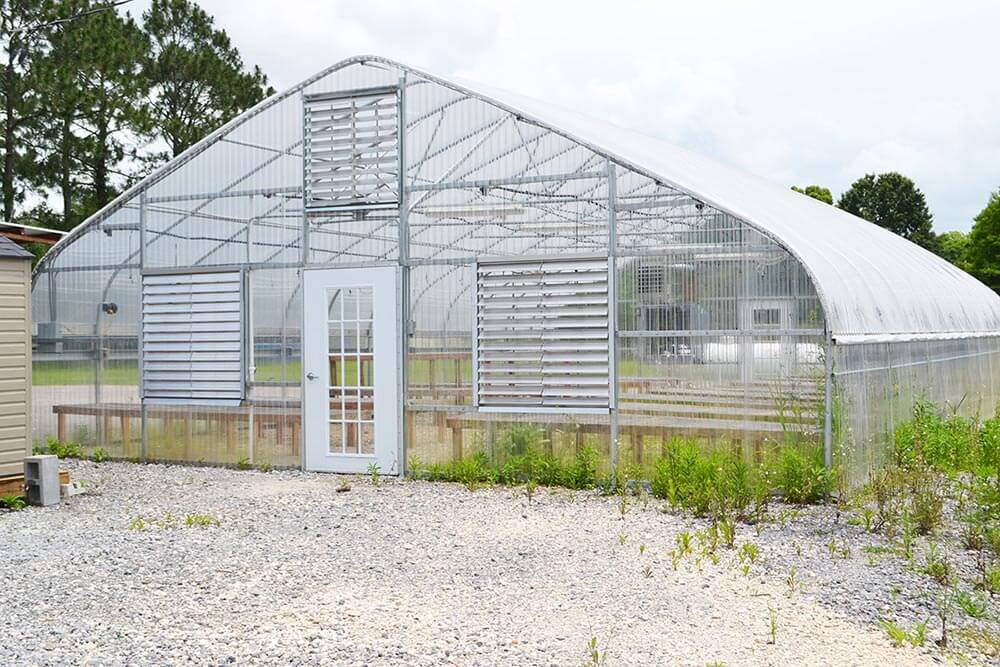BTNEP’s Coastal Restoration Planting Program has expanded through the years as our Volunteer Program has grown. This has allowed us to expand our restoration-planting footprint.
 The addition of a greenhouse to our plant program has allowed us to maximize this expansion. BTNEP’s 4800 sq. ft. shadehouse allows us to collect native seed, pot, and grow out herbaceous and woody species for ridge and upland plantings that benefit Neotropical migratory birds utilizing the Mississippi Flyway each spring and fall, but does not allow us to reliably carry over woody and herbaceous plants from year to year.
The addition of a greenhouse to our plant program has allowed us to maximize this expansion. BTNEP’s 4800 sq. ft. shadehouse allows us to collect native seed, pot, and grow out herbaceous and woody species for ridge and upland plantings that benefit Neotropical migratory birds utilizing the Mississippi Flyway each spring and fall, but does not allow us to reliably carry over woody and herbaceous plants from year to year.
In 2014, in partnership with The Mosaic Company, BTNEP added a 30’ x 48’ greenhouse to its production facility. The greenhouse provides protection from the cold of winter of the woody species currently being grown, allows the ability to carry over these plants year to year and grow them out to two or three year old plants. Repotting and growing out seedlings over a couple of growing seasons allows for the establishment of a plant with a larger root mass, beneficial in areas of low soil moisture.
With the addition of the greenhouse to BTNEP’s shadehouse, BTNEP can meet its objectives of diversifying the plant species used in restoration projects and provide new habitat that the estuarine species depend on. A major benefit of the greenhouse is that BTNEP could add black mangroves to their suite of woody species being used. Black mangroves are very susceptible to the cold require protection during grow out mangroves over the two winters needed to get them to a size in which they can survive in the wild. Black mangroves planted in the estuary provide habitat benefitting avian and fish species.
 The greenhouse also allows the program to maximize its expansion into grasses utilized for shoreline stabilization and dune creation, as well as provide habitat for various birds, fish, and fauna. Currently the program grows out some of the herbaceous species used in these habitats, but because of the plants being left out in the cold over winter, the plants become dormant and are then not ready for restoration plantings until late in the spring or early summer. Ideal planting time for these species is early spring. With these grasses housed in a greenhouse, not only will they not go into dormancy during the winter months, but they will continue to grow and be fully ready for optimal early spring planting.
The greenhouse also allows the program to maximize its expansion into grasses utilized for shoreline stabilization and dune creation, as well as provide habitat for various birds, fish, and fauna. Currently the program grows out some of the herbaceous species used in these habitats, but because of the plants being left out in the cold over winter, the plants become dormant and are then not ready for restoration plantings until late in the spring or early summer. Ideal planting time for these species is early spring. With these grasses housed in a greenhouse, not only will they not go into dormancy during the winter months, but they will continue to grow and be fully ready for optimal early spring planting.
Finally, a greenhouse affords another educational opportunity for the many volunteers and college interns we receive at the farm. BTNEP receives volunteers provide the program with the manpower to pot the thousands of plants which we utilize in our coastal restoration plantings each year and we give them the understanding, not only of the plants, but of the plight of Louisiana’s land loss and what needs to be done to save this economical, environmental, and culturally important area.

